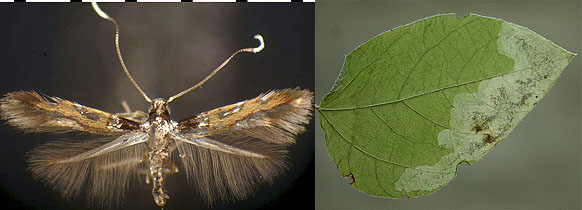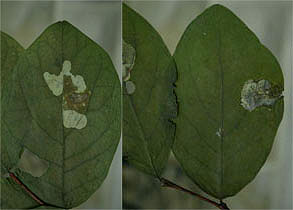
Leucanthiza contains two described North American species, both of which occur in the eastern USA. The larvae form flat, whitish upperside blotch mines, either singly or with several larvae per mine. Pupation occurs outside the mine in a small, typically gracillariine cocoon. Adults of the two species are similarly colored with black, orange, and metallic lead-gray scaling; therefore, rearing is the best bet for obtaining definitively-identified moths of Leucanthiza. Braun (1914) gave characters for differentiating adults of the two species (see below, under L. dircella).
Leucanthiza amphicarpeaefoliella (Fig. 1) feeds on hog peanut, Amphicarpa bracteata (Fabaceae).

Figure 1. Leucanthiza amphicarpeaefoliella. Adult, and leaf mine on hog peanut, Amphicarpa bracteata(Fabaceae).
Leucanthiza dircella (Fig. 2) feeds on leatherwood, Dirca palustris (Thymeliaceae); the moth apparently is not known from Illinois but should be expected where D. palustris occurs (in scattered localities throughout the state).
According to Braun (1914), L. dircella can be distinguished from L. amphicarpeaefoliella by the following three points of forewing coloration:
(1) The dark brown patch at the base does not reach the dorsal margin.
(2) There is a short golden streak near the middle of the dorsum, and an inwardly-oblique, longer one at the tornus.
(3) A straight, full-width transverse golden fascia on the outer edge of the basal dark patch encloses a small patch of orange.

Figure 2. Leucanthiza dircella. Leaf mines on leatherwood, Dirca palustris (Thymeliaceae) (Parke County, Indiana).